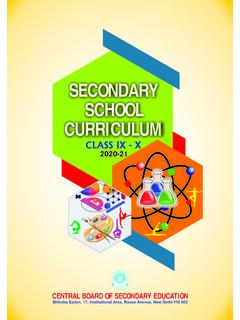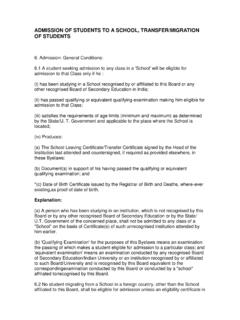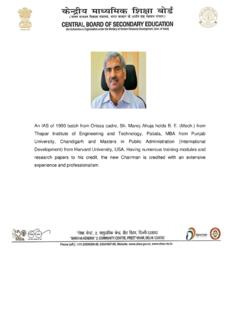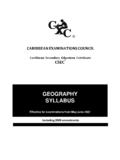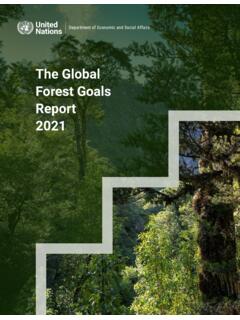Transcription of SENIOR SCHOOL CURRICULUM - Central Board of …
1 SENIOR SCHOOLCURRICULUMCLASS XI - XIICENTRAL Board OF SECONDARY EDUCATIONCENTRAL Board OF SECONDARY EDUCATIONS hiksha Sadan, 17, Institutional Area, Rouse Avenue, New Delhi-110 0022020-211 OF THE CBSE CURRICULUMThe CURRICULUM refers to the lessons and academic content to be taught toa learner in the SCHOOL . In empirical terms, it may be regarded as the sumtotal of a planned set of educational experiences provided to a learner bya SCHOOL . It encompasses general objectives of learning, courses of study,subject-wise instructional objectives and content, pedagogical practicesand assessment guidelines. The CURRICULUM provided by CBSE is based onNational CURRICULUM Framework-2005 and seeks to provide opportunitiesfor students to achieve excellence in Salient Features of the CBSE SENIOR Secondary SCHOOL CURRICULUM The CURRICULUM prescribed by CBSE strives to: ample scope for physical, intellectual and socialdevelopment of students; general and specific teaching and assessment objectives; Constitutional values such as Socialism, Secularism,Democracy, Republican Character, Justice, Liberty, Equality,Fraternity, Human Dignity of Individual and the Unity and integrityof the Nation by encouraging values-based learning activities.
2 Life-Skills by prescribing curricular and co-curricularactivities to help improve self-esteem, empathy towards differentcultures etc.; innovations in pedagogy and assessment to keep pacewith the global trends in various disciplines; inclusive education by providing maximum possible equalopportunities to all students; environmental education in various disciplines; emphasize Co-scholastic areas of General Studies andHealth and Physical Art integrating Objectives of the CURRICULUM The CURRICULUM aims to: desired national level of competencies in cognitive, affectiveand psychomotor domains; acquisition of 21st Century Skills and enhance self andsocial awareness through thematic or multidisciplinary approach.
3 Cooperative Learning, Collaborative Learning, Self directedlearning etc. to facilitate realization of learning outcomes; Authentic Assessments based on real world tasks involvingmeaningful application of knowledge and skills; Life Skills , inculcate values , foster cultural learning andinternational understanding in an interdependent society;2 6. acquire the ability to utilize technology and information for the betterment of humankind; 7. strengthen knowledge and attitude related to livelihood skills and promote lifelong learning; 8. develop the ability to appreciate art and showcase talents; 9. promote physical fitness, health and CURRICULUM Areas at SENIOR Secondary Level For the purpose of fostering competences in learners, the CURRICULUM encompasses seven major learning areas, which are: Languages, Humanities, Mathematics, Sciences, Skill Subjects, General Studies and Health and Physical Education.
4 These areas are broadly divided into Scholastic and Co-scholastic areas as detailed below: Languages Scholastic Areas Academic Electives Skill Electives General Studies Health & Physical Education *Work Experience Co-scholastic Areas *Work experience is subsumed in Health and Physical Education Scholastic Areas: The CURRICULUM envisages individualized personal learning acumen and seeks to explore the potential of students in acquiring substantial knowledge and skills through academic rigors. With greater academic orientation and research skills in core academic areas, students would evolve as discerning young adults with a sense of real self-esteem having true values and principles.
5 The scholastic areas are as follows: (i) Languages include Hindi, English and other 30 languages. The curricula in languages focus on listening, speaking, reading and writing skills and to develop effective communicative proficiency. Learners use language to comprehend, acquire and communicate ideas. (ii) Subjects like Geography, History, Economics, Home Science, Sociology, Fine Arts, Political Science, Fashion Studies, and related subjects promote the learning of history and culture, geographical environment, global institutions, constitutional values and norms, politics, economy, interpersonal and societal interactions, civic responsibilities and the interplay of the above-mentioned learning.
6 Learners appreciate and value every human's right to feel respected and safe, and, in this regard, also understand their Fundamental Rights and Duties and behave responsibly. Learners learn to be tolerant and empathetic towards others through the study of these subjects. 3 (iii) Subjects like Biology, Chemistry, Physics, Computer Science, Informatics Practices help in making students perceptive about matter and energy, nature, the environment, technology breakthrough in science. The focus is on knowledge and skills to develop a scientific attitude and to use and apply such knowledge for improving the quality of life.
7 This learning can be used to analyze and evaluate existing scenarios and propose innovative solutions to situations. Learners understand and appreciate the physical, biological and technological world and acquire the knowledge and develop attitude, skills and values to make rational decisions in relation to it. (iv) Mathematics includes acquiring the concepts related to numbers, operations, computation, measurement, geometry, probability and statistics, the skill to calculate and organize and the ability to apply this knowledge and acquired skills in their daily life. It also includes understanding of the principles of reasoning and problem solving.
8 Learners identify, integrate and apply numerical and spatial concepts and techniques. They have clarity of concepts and are able to connect them to the real world. Learners rationalize and reason about pre-defined arrangements, norms and relationships in order to comprehend, decode, validate and develop relevant patterns. (v) Subjects like Business Studies, Accountancy, Entrepreneurship, Economics and related subjects help in gaining understanding about core business disciplines. They understand the concept like, the exchange of items of value or products between persons or companies and the meaning / relevance/ Significance of any such exchange of money for a product, service, or information.
9 (vi) Subjects like Dance, Drama, Music, Heritage Crafts, Fine Arts, Sculpture and related subjects aim to help learners cultivate an interest and appreciation for arts and encourage them to enthusiastically participate in related activities, thus, promoting abilities such as imagination, creativity, value arts, and the cultural heritage. (vii) Skill Electives help in development of professional competencies, which are analytical, applied and outcome based. Undergoing skills training in schools can help students learn about a trade progressively to create a product and also to become a problem solver in real life. At present many Skill electives are being offered by the Board in the fields of Hospitality and Tourism, emerging technology like Artificial Intelligence, Geospatial Technology, Finance, Business, Retail & Insurance etc.
10 Students can also choose subject from diverse areas such as Fashion Design, Agriculture, Banking, Mass-Media Healthcare and many more. Co- Scholastic Areas: Co-curricular activities aim at development and using knowledge and skills in different fields to groom the overall personality and character of 4 students. It includes Health and Physical Education including Work Education and SEWA, various Creative Arts like Painting, Crafts, Dance and Music, and social activities. Instead of co-curricular activities, the term co- scholastic activities is used as both cognitive and non-cognitive development can take place by exposing the child to the lesson on scholastic subjects and non-scholastic subjects.

